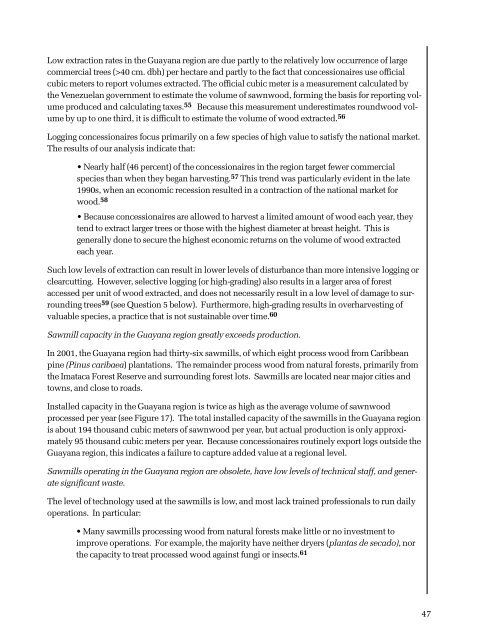Usar pâgs xvii-134 - ResearchGate
Usar pâgs xvii-134 - ResearchGate
Usar pâgs xvii-134 - ResearchGate
Create successful ePaper yourself
Turn your PDF publications into a flip-book with our unique Google optimized e-Paper software.
Low extraction rates in the Guayana region are due partly to the relatively low occurrence of largecommercial trees (>40 cm. dbh) per hectare and partly to the fact that concessionaires use officialcubic meters to report volumes extracted. The official cubic meter is a measurement calculated bythe Venezuelan government to estimate the volume of sawnwood, forming the basis for reporting volumeproduced and calculating taxes. 55 Because this measurement underestimates roundwood volumeby up to one third, it is difficult to estimate the volume of wood extracted. 56Logging concessionaires focus primarily on a few species of high value to satisfy the national market.The results of our analysis indicate that:• Nearly half (46 percent) of the concessionaires in the region target fewer commercialspecies than when they began harvesting. 57 This trend was particularly evident in the late1990s, when an economic recession resulted in a contraction of the national market forwood. 58• Because concessionaires are allowed to harvest a limited amount of wood each year, theytend to extract larger trees or those with the highest diameter at breast height. This isgenerally done to secure the highest economic returns on the volume of wood extractedeach year.Such low levels of extraction can result in lower levels of disturbance than more intensive logging orclearcutting. However, selective logging (or high-grading) also results in a larger area of forestaccessed per unit of wood extracted, and does not necessarily result in a low level of damage to surroundingtrees 59 (see Question 5 below). Furthermore, high-grading results in overharvesting ofvaluable species, a practice that is not sustainable over time. 60Sawmill capacity in the Guayana region greatly exceeds production.In 2001, the Guayana region had thirty-six sawmills, of which eight process wood from Caribbeanpine (Pinus caribaea) plantations. The remainder process wood from natural forests, primarily fromthe Imataca Forest Reserve and surrounding forest lots. Sawmills are located near major cities andtowns, and close to roads.Installed capacity in the Guayana region is twice as high as the average volume of sawnwoodprocessed per year (see Figure 17). The total installed capacity of the sawmills in the Guayana regionis about 194 thousand cubic meters of sawnwood per year, but actual production is only approximately95 thousand cubic meters per year. Because concessionaires routinely export logs outside theGuayana region, this indicates a failure to capture added value at a regional level.Sawmills operating in the Guayana region are obsolete, have low levels of technical staff, and generatesignificant waste.The level of technology used at the sawmills is low, and most lack trained professionals to run dailyoperations. In particular:• Many sawmills processing wood from natural forests make little or no investment toimprove operations. For example, the majority have neither dryers (plantas de secado), northe capacity to treat processed wood against fungi or insects. 6147
















